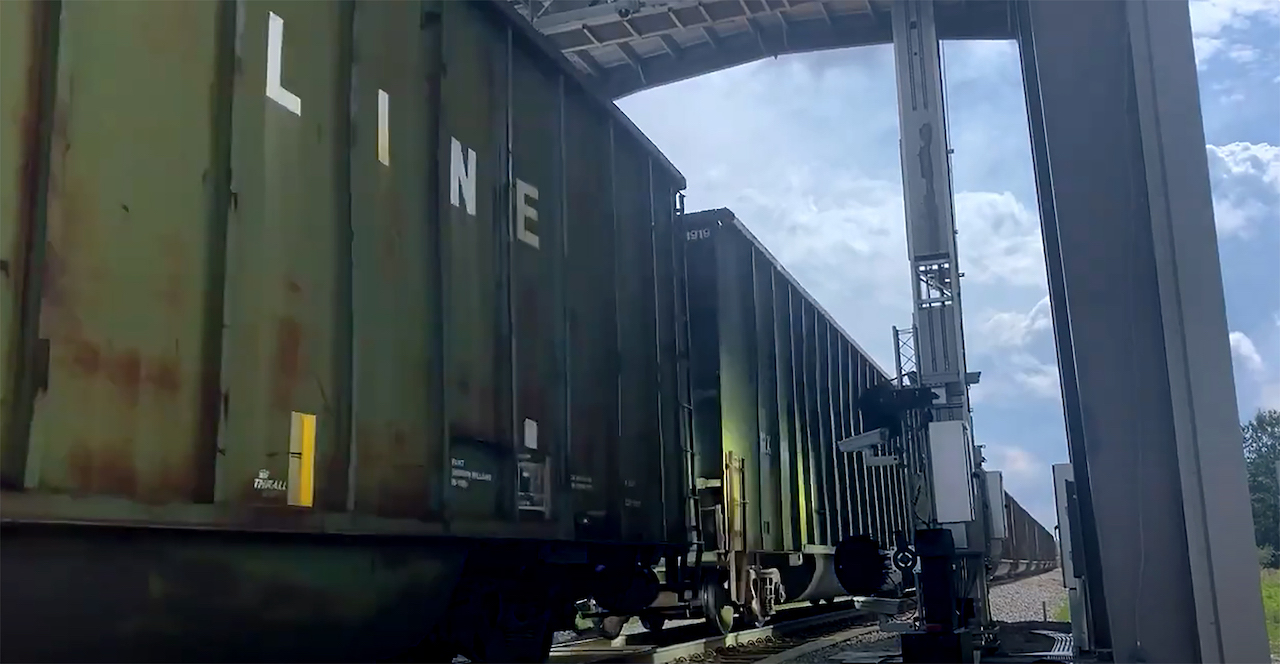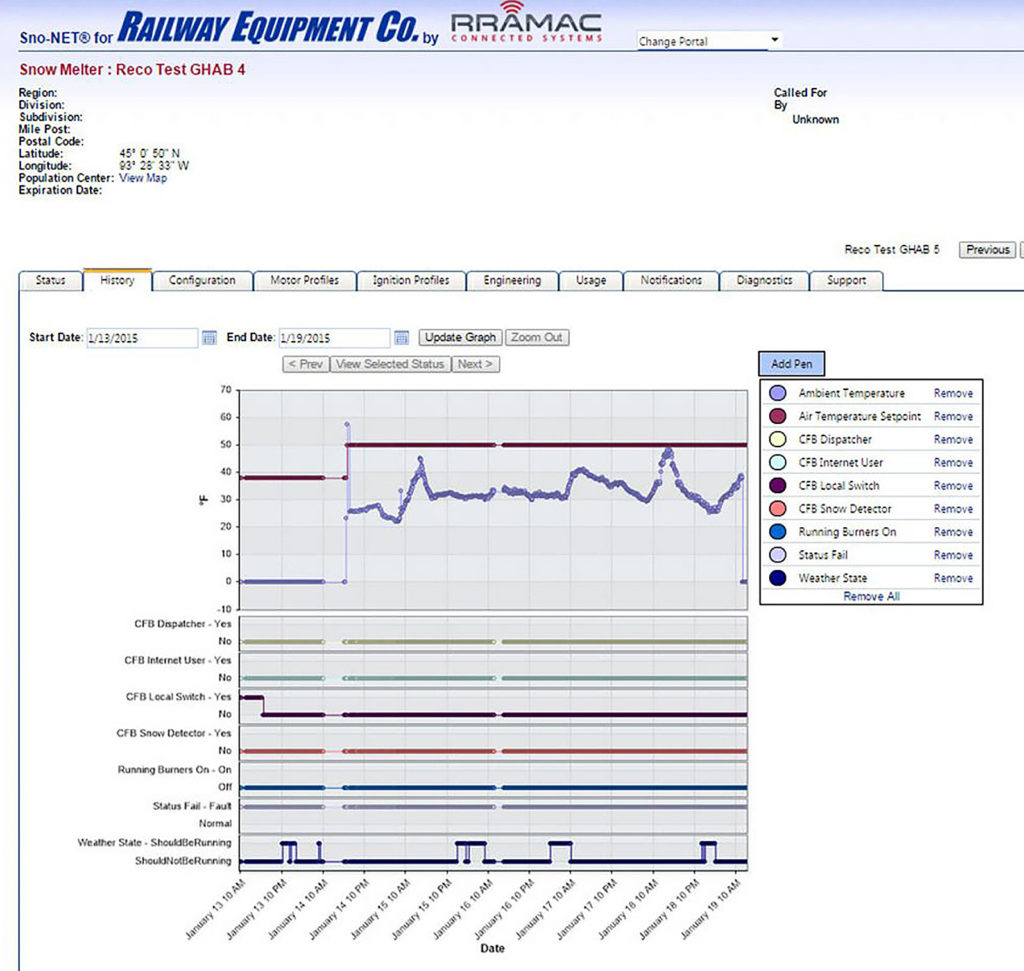
Continuous Real-Time Checkups
Written by William C. Vantuono, Editor-in-Chief
Duos Technologies photo
RAILWAY AGE, NOVEMBER 2023 ISSUE: Technologies that leverage AI are improving the way railroads operate and maintain equipment and infrastructure.
Wayside equipment covers a wide spectrum of functions, from grade crossing and interlocking controllers to PTC wayside interface units. It’s a heavy lift to inspect, keep track of and respond to failures. Artificial intelligence (AI) and remote, real-time health monitoring are disruptive technologies improving the way railroads operate, and how they maintain infrastructure. Among the suppliers offering this capability are ENSCO, RECO (Railway Equipment Co.), Alstom, Frauscher, Hitachi Rail USA, HTI (Herzog Technologies Inc.), Trimble, Wabtec and Siemens Mobility.
RECO’s Rail-NET™ is described as “a remote monitoring system to collect and circulate pertinent asset operating data to the right personnel at the right time. Railroad defined data is collected via RECO’s various interface modules that monitor a variety of analog and digital inputs. Data is then transmitted to a secure online portal for processing and accessibility. The portal allows the user to customize the data presentation, as well as when an alert should be sent out and to whom. Customization of asset tracking and alerts are sent whenever an asset is operating outside normal parameters. Railroads can remotely determine the status of their equipment and prioritize their responses to better utilize their maintenance resources. With remote monitoring, a site visit is no longer needed to determine the problem. Instead, information provided through remote monitoring ensures the maintenance personnel are equipped to correct the situation before traveling to the asset.”
Rail-NET™ provides monitoring, including voltage and currents, of all wayside equipment: battery systems, switch machines (operation and transition time), generators, weather stations, video camera systems, with a digital text display for field monitoring and adjustments and a customizable web interface.
Duos Technologies’ Railcar Inspection Portal (RIP®, above) is sescribed as “an advanced, AI-enabled railcar imaging system that produces high-resolution images of railcars moving at track speeds. The wide array of images offer a 360⁰ view of each railcar, including the undercarriage. An intuitive, graphical user interface allows mechanical railcar inspectors to scan trains, review railcars and perform detailed inspections rapidly.”
Optional RIP® AI modules “help elevate inspections to a highly automated process. Professionally developed AI models are available to target and identify a wide variety of specific railcar defects, providing inspectors with alerts and notifications. Inspection time is reduced and immediately draws attention to targeted areas of interest.” Oblique Vehicle Undercarriage Examiner “captures areas of interest on the car or locomotive underside, including truck inner spring nest, traction motors, axles, brake components, bolsters and, in most cases, wheel conditions.” Oblique Truck View is “an intelligent imaging system that provides high-resolution images of truck side frames, roller bearing adapters, and other critical components.”
ENSCO notes that its engineers “have pioneered the use of technologies, such as advanced rail inspection sensors, high-resolution imaging technology and autonomous inspection systems.” Though much of the company’s systems are track inspection-based, ENSCO also offers technology for assessing the condition of train control and signaling systems.

ENSCO’s Signal & Communication Inspection System (SCIS) is used to measure AC track circuits and associated train control systems in addition to wayside train control systems “to ensure that they are operating as intended. The SCIS provides an added level of protection as an independent condition monitoring tool to the train control system itself.”
The machine vision capability of ENSCO’s Track Component Imaging System (TCIS) “allows for a visual inspection of train control components, such as balises and transponders. This allows railways to identify problems of broken, missing or incorrectly located wayside transponders that can result in incorrect train control operations.” The related Joint Bar Inspection System (JBIS) “allows for the visual inspection of important track circuit components, such as bond wires to aid in diagnosing track circuit problems. These wires and connections can become damaged or partially damaged causing issues with track circuits and train control and grade crossing protection systems.”
Trimble just released its T4D (Trimble® 4D) Control™ software version 6.5, which “expands its track monitoring capabilities to address a wider range of standards and specifications. This update also adds support for Syscom Instruments acceleration sensors for event-based monitoring of ground motion, as well as updating authentication methods for improved security.” The T4D Rail module “provides the flexibility to use wireless tiltmeters or automated monitoring total stations (AMTS) to monitor track geometry. It also simplifies data management, analytics and deliverables through the automatic calculation of key rail parameters to lessen in-office processing time and reduce errors from manual processes. Real-time, rail-specific visualization and analysis, and automated alarming of key track parameters deliver crucial information on track geometry and stability.”
In 2022, Wabtec acquired Trimble’s Beena Vision business, which “provides vision-based wayside detectors for the rolling stock maintenance market with non-contact measurement technology providing a detailed condition assessment of train components ranging from wheel surface condition to full train inspection, while operating in service and at high speeds. Coupled with Wabtec’s TrackIQ portfolio, it creates a comprehensive wayside inspection offering.”
Norfolk Southern (NS) has begun deploying its own Digital Train Inspection Portal (DTIP)equipped with Machine Vision Inspection technology developed in partnership with the Georgia Tech Research Institution (GTRI), which engineered the hardware, and NS’s Data Science/AI and Mechanical groups. The project, NS says, “aims to supercharge NS’s safety infrastructure and inspection processes” with more than a dozen DTIPs to be deployed by late 2024.
DTIPs are equipped with an array of 24-megapixel trackside cameras and stadium lighting. Machine Vision Inspection technology captures ultra-high-resolution, 360-degree images of passing railcars. The cameras are synced to the microsecond, taking 1,000 images per railcar on average as they pass through the portal at speeds up to 70 mph. The high-speed cameras are strategically placed at angles “to capture things that are difficult to detect with the human eye during stationary inspections. In addition, capturing images while the train is in a dynamic state provides an inspection for various defects that cannot be done while the train is stationary.”
AI analyzes these images for potential defects. According to NS, the railroad’s in-house Data Science/AI team has developed 38 advanced Deep Learning algorithms and has already deployed them across heavily trafficked lanes. “These best-in-class, field-proven algorithms have demonstrated very high accuracy levels, while having very low false-positives,” NS says. AI transmits information to NS’s Network Operations Center where the data is reviewed by subject-matter experts to “identify and address issues to proactively ensure the safety of rail operations.” Critical defects found are flagged for immediate handling. The first portal was deployed in Leetonia, Ohio, where trains pass through approximately every hour.



